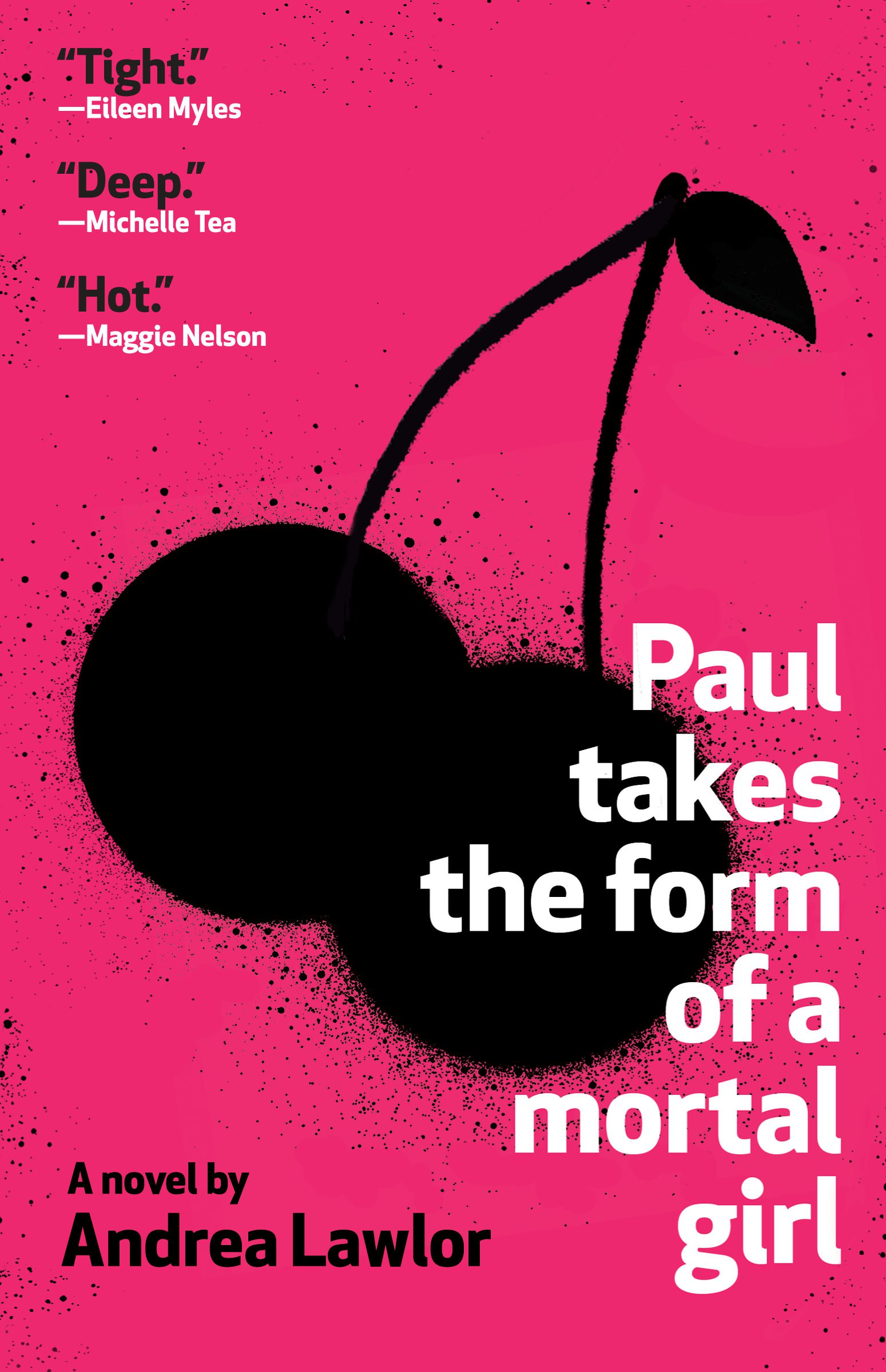
Just over a hundred pages into Andrea Lawlor’s novel, Paul Takes the Form of a Mortal Girl, something unusual happens. Paul, who can change his gender at will, has attended the Michigan Womyn’s Music Festival as a woman, and has met Diane, a carpenter who can talk to animals. They have fooled around in the woods, and Diane has saved Paul from a bear, but none of that is so unusual in the context of this gritty quasi-fairy tale, set in the 1990s.
What’s unusual is that, for the first time, its shapeshifting main character wants to see if a random hook-up could lead to something solid, and lasting. So, once he’s back home, Paul decides to “explain something to Diane in the only way he [knows] how.” He decides to make her a mixtape.
I experienced this novel twice. The first time, I read it on a laptop; the second time, it was read to me, over the course of four days, by a voice actor in a studio. For about two years now, I have worked as an audiobook director. The job is to coach an actor or author through their performance, and make sure, among other things, that they stay connected to the book’s subtext and spirit. The mixtape scene was the moment where the novel began to click for me on a deeper level. I began to see its natural laws, its structure, and its illusive main character more clearly.
By the time the scene arrives, Paul has flitted from one experience to the next, hunting for quickies with strangers and fixating on clothes, faces, surfaces: appearances. “It is only shallow people who do not judge by appearances,” said Oscar Wilde, whose name adorns a gay bar Paul used to frequent in New York. “The true mystery of the world is the visible, not the invisible.” Paul’s story has been suffused with such surface-enigma, an episodic, erotically charged journey through several American cities and their dive bars and places to crash.
But here, as Paul sits on his bedroom floor, circled by “unsteady stacks” of CDs and cassettes, it starts to become clear what Lawlor is up to. Paul’s many ideas about art and culture have not been merely opinions (or period references, sprinkled in to establish the book’s setting). They have been plot. Paul—who can become anyone, and who, in his mind, can trick himself into being attracted to just about anyone—is on a quest to discover who he is and what he really wants. Making a mixtape (for the purposes of this essay, an album curated by an amateur for an uncommercial, “sentimental” reason, rather than, say, a hip-hop mixtape released by a musician, or a compilation released by a label) is not so different from shapeshifting—from trying on new selves. Obsessing about the songs of others, and how they are ordered, and what meanings they signal, is, in this novel, important narrative action.
It’s also character: “The first tape you ever got from someone,” Paul thinks, “was always an adjustment in how you thought of them, an insight into how they saw themselves.” It said something about both giver and receiver. It was a way of signaling intent and shared understanding, of offering friendship or playing footsie across time and space.
The novel overflows with Lawlor’s tenderness for the Gen-X era and its lost arts. Just as nineteenth-century authors used the writing of love letters, or the sleepless nights of teeth-gnashing before early morning duels, Lawlor uses the act of making a mixtape to show us their character’s mind at work. As Paul opens jewel cases, and thinks of Diane, he sounds like a writer, or a person picking out clothes before a date:
Paul was happy with Side A, though not entirely sure about that last track [Echo and the Bunnymen’s “People are Strange.”] Also, maybe “Me-Jane” would have been a better PJ Harvey track after “Golden Thing” because of the beat, but the lyrics weren’t romantic. Paul knew that some people didn’t consider the lyrics when making mixtapes, but he always did. Occasionally he’d choose a song for ironic purposes or to say the opposite of what the lyrics said or for litote (for instance, “Rid of Me”) but always lyrics were involved in the decision. Paul disliked instrumental music. He wanted stories, all the time.
For Paul, thinking about music is also a way to clarify his thinking about gender. Earlier in the story, Lawlor gifts Paul an epic riff on how “the best cover songs fuck with gender.” After having taken acid with a boy named Dallas, Paul describes covers that deliver the “age-old simple pleasures of drag—knowledge, the opportunity to investigate the simulacra and make comparisons, that obscure little frisson of dissonance,” making his case with examples from Joan Baez’s cover of the “Night They Drove Old Dixie Down” to the Raincoats’ version of “Lola.”
Lawlor uses Paul’s aesthete’s hungry browsing mind to bring us closer to his emotional core, and as I read these mixtape scenes, I started to think back on earlier moments in a new way. When, for instance, on page twenty-seven, Paul adjusted his height to make his pants fit better, I assumed he was just being magical, like when Marry Poppins slides up the banister rather taking the stairs. But now that I understood Paul better, there was more resonance to that small moment, to how a young person shrinks and expands, amplifies and self-censors seemingly a thousand times a day to fit themselves to the world.
As he makes his mixtape for Diane, Paul remembers a mix from an old boyfriend, and weighs plagiarizing part of it:
Was it entirely ethical to copy a song, or multiple songs, from a mixtape someone else had made you? What if you changed the order? …Paul decided it was okay if the tape had been given to you in the spirit of true love and had then become part of who you now were. It was not just okay, it was in fact crucial, then, to share this with your new love, so they could understand you.
In other words, if it becomes a part of us, it’s ours. The search to define oneself by one’s taste is superficial in an unmysterious, unmeaningful way if it isn’t done in this spirit of love.
From 2004 through 2016, my friend Josh and I would make each other mixes. Though we’re just friends, it was certainly done with love, considering the crazy amount of time and thought we would put into them. With some of Josh’s best mixes, even the gaps between songs could get stuck in my head. The highest praise I could give would be for the transitions, how one song set up the next. Sometimes the pause could feel acrobatic, weightless. We would put secret tracks at the end, too, but those lost their oomph when you imported them into iTunes and would see them exposed there at the end, like someone caught trying to sneak on a plane in a suitcase.
Secret tracks have gone the way of other, more critical privacies, but for those of us who got to experience even the tail end of the mixtape era, we still felt a sense of our selves expanding along with our music collections, and we still have memories filled with songs and the gaps between them.
One surprise of this book about a shapeshifter’s hunt for a solid sense of self is that it need not be read as pure allegory. In fact, the interstitial, full-on fairy tale sections, which hint at providing Paul’s origin story while also pointedly conflicting with one another, seem to urge the reader not to get too literal and connect-the-dots about it. As the band Pulp used to write in their liner notes, “Please do not read the lyrics whilst listening to the recordings.”
It’s a widely known factoid that the body’s cells regenerate completely every seven years. Personal experience—twilight moments as we wake up from sleep, selfless—shows us that, even in the course of twenty-four hours, a self is not a solid, unchanging fact. It is, rather, in flux, like music—something you remember, and hum to yourself, and sometimes forget and make up as you go along. Lawlor does not force any conclusions as to who their main character will become. Instead, they present Paul as a character who is not always sure of his identity, or his choices, but who also naturally intuits a hidden magic to uncertainty: “He wasn’t sure about any of the last three songs, really, but sometimes the songs you weren’t sure about were the genius choices.”
A few days before I was scheduled to direct the audiobook for Paul Takes the Form of a Mortal Girl, I spoke to Lawlor and the actor Dani Martinek on the phone. Lawlor also emailed us references to help evoke the qualities they hoped we might capture in the studio. Among the links to film clips, and the voices of poets reading their work, was a Spotify playlist Lawlor had made of every single song that appears in the novel. It was, in their words, “a document of my procrastination.” With their permission—and presented in the spirit of a mixtape—here is that playlist:
https://open.spotify.com/playlist/6yfFU0hPZdUHgYiPVasxrr





